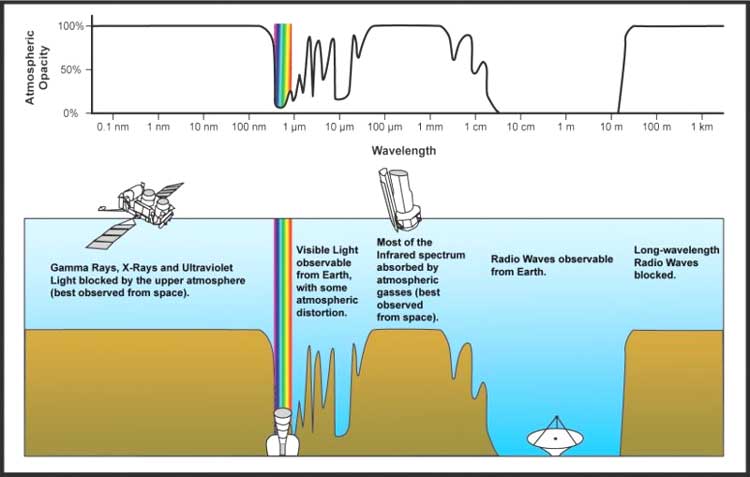.
Telescope

A diagram of the electromagnetic spectrum with the Earth's atmospheric transmittance (or opacity) and the types of telescopes used to image parts of the spectrum.
A telescope is an instrument designed for the observation of remote objects and the collection of electromagnetic radiation. "Telescope" (from the Greek tele = 'far' and skopein = 'to look or see'; teleskopos = 'far-seeing') was a name invented in 1611 by Prince Frederick Sesi[1] while watching a presentation of Galileo Galilei's instrument for viewing distant objects. "Telescope" can refer to a whole range of instruments operating in most regions of the electromagnetic spectrum.
Types of telescopes
The name "telescope" covers a wide range of instruments and is difficult to define. They all have the attribute of collecting electromagnetic radiation so it can be studied or analyzed in some manner. The most common type is the optical telescope. Other types also exist and are listed below.
Optical telescopes
Main article: Optical telescope
An optical telescope gathers and focuses light mainly from the visible part of the Electromagnetic spectrum (although some work in the infrared and ultraviolet). Optical telescopes increase the apparent angular size of distant objects, as well as their apparent brightness. Telescopes work by employing one or more curved optical elements - usually made from glass - lenses or mirrors - to gather light or other electromagnetic radiation and bring that light or radiation to a focus, where the image can be observed, photographed, studied, or sent to a computer. Optical telescopes are used for astronomy and in many non-astronomical instruments, including: theodolites (including transits), spotting scopes, monoculars, binoculars, camera lenses, and spyglasses. There are three main types:
* The refracting telescope which uses solely an arrangement of lenses (excluding star diagonals).
* The reflecting telescope which uses solely an arrangement of mirrors (excluding eyepieces).
* The catadioptric telescope which uses a combination of mirrors and lenses, and usually have a glass corrector plate at the front.
Radio telescopes
Main article: Radio telescope
Radio telescopes are directional radio antennae that often have a parabolic shape. The dishes are sometimes constructed of a conductive wire mesh whose openings are smaller than the wavelength being observed. Multi-element Radio telescopes are constructed from pairs or larger groups of these dishes to synthesize large "virtual" apertures that are similar in size to the separation between the telescopes: see aperture synthesis. As of 2005, the current record array size is many times the width of the Earth, utilizing space-based Very Long Baseline Interferometry (VLBI) telescopes such as the Japanese HALCA (Highly Advanced Laboratory for Communications and Astronomy) VSOP (VLBI Space Observatory Program) satellite. Aperture synthesis is now also being applied to optical telescopes using optical interferometers (arrays of optical telescopes) and Aperture Masking Interferometry at single reflecting telescopes. Radio telescopes are also used to collect microwave radiation, often used to help study the leftover Big Bang radiation, and also can be used to collect radiation when visible light is obstructed or faint, such as from quasars. Some radio telescopes are used by programs such as SETI and the Arecibo Observatory to search for exterrestrial life. (see also: Wow! Signal)
X-ray and gamma-ray telescopes
Main articles: X-ray astronomy and gamma-ray astronomy
X-ray and gamma-ray radiation go through most metals and glasses, some X-ray telescopes use Wolter telescopes composed of ring-shaped "glancing" mirrors, made of heavy metals, that reflect the rays just a few degrees. The mirrors are usually a section of a rotated parabola and a hyperbola or ellipse. Gamma-ray telescopes refrain from focusing completely, and use coded aperture masks; the pattern of shadows the mask creates can be reconstructed to form an image.
These types of telescopes are usually on Earth-orbiting satellites or high-flying balloons, since the Earth's atmosphere is opaque to this part of the electromagnetic spectrum.
Other types
* Binoculars
* Spotting scopes
* Monoculars
* Telephoto lens
* Solar telescope
* Theodolites
Notable telescopes
* Anglo-Australian Telescope
* Arecibo Observatory
* Atacama Large Millimeter Array
* Chandra X-ray Observatory
* CHARA (Center for High Angular Resolution Astronomy) array
* Hale telescope
* Hexapod-Telescope
* Hooker Telescope
* Hubble Space Telescope
* IceCube Neutrino Detector
* Isaac Newton Telescope
* Keck telescope
* LIGO
* McMath-Pierce Solar Telescope
* McMath-Hulbert Observatory (Solar)
* Magdalena Ridge Observatory
* Multiple-Mirror telescope
* Navy Prototype Optical Interferometer
* Overwhelmingly Large Telescope (proposed)
* Parkes Observatory
* Southern African Large Telescope
* Subaru Telescope
* UK Schmidt Telescope
* Very Large Array
* Very Large Telescope
* Westerbork Synthesis Radio Telescope
* William Herschel Telescope
* XMM-Newton
See also
* Amateur telescope making
* Angular resolution
* Aperture synthesis
* ASCOM open standards for computer control of telescopes
* BOOTES
* Depth of field
* Dynameter
* Eyepiece
* First light
* f-number
* History of telescopes
* Keyhole problem
* List of largest optical reflecting telescopes
* Microscope
* Nimrud lens
* Remote Telescope Markup Language
* Robotic telescope
* Space observatory
* Timeline of telescope technology
* Timeline of telescopes, observatories, and observing technology
Notes
1. ^ antiquetelescopes.org - An early history of the telescope
References
* Contemporary Astronomy - Second Edition, Jay M. Pasachoff, Saunders Colleges Publishing - 1981, ISBN 0-03-057861-2
* Elliott, Robert S. (1966), Electromagnetics, McGraw-Hill
* Rashed, Roshdi & Régis Morelon (1996), Encyclopedia of the History of Arabic Science, vol. 1 & 3, Routledge, ISBN 0415124107
* Wade, Nicholas J. & Stanley Finger (2001), "The eye as an optical instrument: from camera obscura to Helmholtz's perspective", Perception 30 (10): 1157-1177
Retrieved from "http://en.wikipedia.org/"
All text is available under the terms of the GNU Free Documentation License

